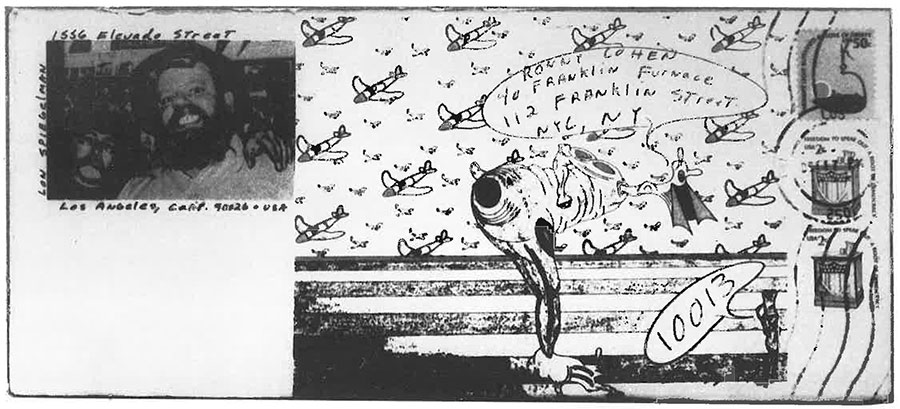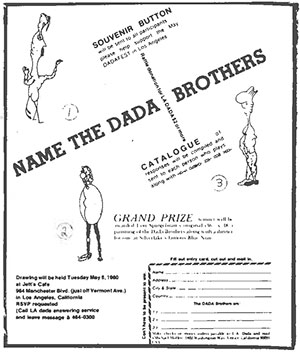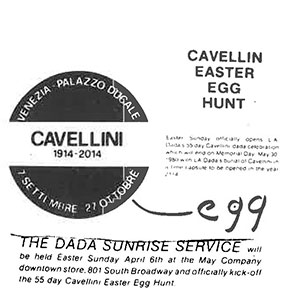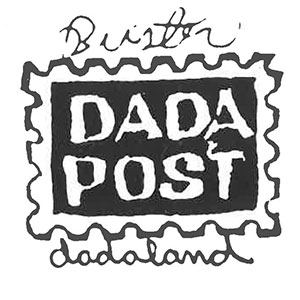Lon Spiegalman: A history of Los Angeles Mail Art (1978 through 1983)
Lon Spiegalman: A history of Los Angeles Mail Art (1978 through 1983), in: Mail Art Then and Now, The Flue, Vol. 4, No. 3-4 (special issue), 1984 Winter, pp. 29-31.

LON SPIEGELMAN. ENVELOPE. 1983.
For the past six years of my life, living in Los Angeles, I've been playing mail-art to the tune of 40-60 hours a week and I still find it impossible to synthesize a universal definition of what mailart is all about.
As I look about my mailart den (the factory, as Bern Porter called it when he visited) I see the faces of mailart friends who I have come to know. It's almost impossible to think of what life was like before these like-minded artists touched my soul.
I could write about any one of the 3-400 different mailartists from anyone of 30 countries with whom I correspond, but their basic stories would be similar.
I feel that the bottom line of mailart is the fact that it is a support system for artists around the world to keep producing and practicing that art which God has put in our souls, while we maintain our families and homes and whatever else is precious to us. I keep going back to that statement which I read from Zabala a long time ago that "Art Is A Prison". I feel that this is true. We can't live with it and we can't live without it. So, what do we do? ... MAILART. Lets thank God for the international postal system which keeps we artists from being isolated while finding our way out of the established maze of rejection and degradation.
I sincerely believe that mailart activity points to a political realization which will have to come about if we are to survive on this planet. It typifies the finest points in each of the battling giants (capitalism and communism). Shows are truly a social effort, displaying a whole that is indeed greater than the sum of its individually produced and free parts. It's a collage.
Like Zabala says, "Art is a prison." Mailart keeps one sane and alive and producing in a world that demands one's time performing mundane tasks in order to pay the bills. Also, mailart offers hope, through exposure, that someday the great discoverer in the sky will recognize the validity of one's work and free the talent's time to share its gift with society. And, if we're only kidding ourselves, well, that's OK tooooo.
There seems to be a duality in the mailart mind which hinders the construction of this retrospective view of Los Angeles' mailart activities. On the one hand mailartists are extremely skeptical of these overviews because no one person knows it all while on the other hand we have a thirst for some kind of sense and order to be made out of all of these divergent mailart-related happenings. The only way to really know mailart is to live it. Every mailartist has a different view and approach to the network: A lot of egos in the art soup. Where does the beginning begin and where do the boundaries of the spotlight end?
What comes to mind as an illustration is the interview I did with oldtime Dada mailartist Buster Cleveland in September of 1981. While Buster was visiting Los Angeles for a couple of weeks before continuing on to New York with Linda Burnham, publisher of "High Performance" magazine, he stayed at my house for a week and helped me paint my kitchen. During the previous year at lnterDada '80 when I met Buster for the first time, he referred to me as a "third generation" mailartist. This concept stuck with me and as we painted and drank them zesty malts, as Dr. Ackerman is so fond of saying, I began writing down his responses to my questions concerning dada and the early days of mailart.
After he left, I made several copies of the interview along with his lists of first, second and third. generation mailartists. Even before I mailed these few copies out to the network, I started receiving very negative responses from some local mailart newcomers who had merely heard about the article. And, eventually, the network's response was less than enthusiastic. Maybe because too much of Buster's ego was involved, I don't know. Or, maybe it was because others viewed things differently. However, I feel that Buster's observations, no matter how skewed, added sense and order to mailart's Tower of Babel.
What I'm trying to ask myself is "whether or not mailart is truly too anarchistic for even reviews." However, this mailartist is somewhat structured and I feel that I am a third generation mailartist whose birthday is February 1978 coinciding with the Artwords/Bookworks Show at the Los Angeles Institute of Contemporary Art, curated by Judy Hoffberg and Joan Hugo.
The Artwords/Bookworks show was the first major mailart happening in Los Angeles to awaken local artists to the international mailart network's existence. That exhibition, consisting of 549 international artists, germinated into an intertwining growth consisting of an approximated 66 significant mailartrelated happenings over the next six years, similar to a family tree branching out in many directions.
Basically, the three main branches of this mailart tree consist of "shows," "out-of-town visiting mailart dignitaries" and "related mailart happenings."
During the past six years, 28 mailart shows have been presented in the greater Los Angeles area. Some have been large and public while·others have been small and more personal. Some have produced catalogues and others have not. Being that space limits any review of these shows, they are merely listed at the end of this article for reference.
The second major mailart happening to leave its mark on Los Angeles was Dadafest L.A., which was organized in May of 1980 by Michael Mollett, Neal "Skooter" Taylor and Patty Sue Jones.
Mailart events for the two-year period between the Artword/Bookworks show and Dadafest were sparce; however, visiting dignitaries, as I like to refer to our out-of-town-mailart friends, started visiting Los Angeles on more of a regular basis.

MAY DADAFEST. Los Angeles. May 1980. Courtesy of Lon Spiegelman.
Other than, budding mailartist, Marilyn Rosenberg's visit in July of 1978, that year was taken up personally by me being inundated with mail from my Artwords/Bookworks mailing. That's how I got involved in mailart. I wrote a postcard to all 549 artists in the show catalog and asked if "they wanted to trade works?" By October I had received something like 200 positive responses.
In April of 1979 Michael Mollett, a second generation correspondence artist, gave a mailart-slide lecture at the Old Venice Jailhouse near his home in Venice. Mollett initially got involved in mailart in 1976 by using R. Mutt's mailing list and catalogues to mail out 1500 postcards into the network, asking for "questions" which he would then paint on the side of his 1964 VW bus and drive around the city, changing questions each week. Michael told that R. Mutt, one of L.A.'s founding mailartists, died in late 1978 of an apparent heart attack.
Three months after the Jailhouse, Steve Hitchcock, editor of the now defunct "Cabaret Voltaire" magazine came up from San Diego with his saxophone to visit. Around the same time Geoffrey Cook, conceptual/performance artist, came down from San Francisco and performed his "Doggie Dinner" piece at the LACE gallery in downtown L.A.
Two months later Tohei Horiike, the Ray Johnson of Japanese mailart, visited with us for a week, continuing work on his Five Years Research Project.
The year of 1979 ended with me, Mollett, and his roommate Steve Granach, a photographer, and dog Homer rolling down Colorado Blvd. in Mallet's VW bus as part of the DooDa Parade, the day prior to the official Rose Parade, me pounding out rhythm on the hood, Steve blowing bubbles at Homer barking and Michael throwing out bogus dada dollar bills to the hungry crowd. We saw Hoffberg along the route, taking pictures for "Umbrella" and bumped into Dan Barber, a Pasadena mailartist/carpenter, sipping Jack Daniels Black Label.
The new decade opened when Bern Porter (physicist, first American publisher of Henry Miller's works, and grandfather of self-published artist' books and more) jumped ship for a night from one of his cruises around the world to give a lecture on found poetry at the newly established Artwords/Bookworks bookstore in Venice, owned by Hoffberg, Lael Mann and Barbara Pascal.
Hoffberg had already begun to be a focal point for mailart in Los Angeles with the bookstore and her establishment of "Umbrella" magazine which began soon after the Artwords/Bookworks (A/B) show.
I believe that the A/B show was the demarcation of a mailart generation, just as Pearl Harbor was the symbolic demarcation of the WWII baby-boom generation. I don't know what the inclusive ending date would be. It's more a state of mind than anything else. And, I feel it to be the same with mailart generations. It's impossible to finely-slice the ending of one and the start of another. It's a frame of mind bounded by specific events, like the depression years, WWII, the 1950's, and the 1960's and the A/B show and in relation to Los Angeles, Dadafest L.A. in May of 1980 which psychologically might demarcate the beginning of fourth generation mailart in Los Angeles.
Dadafest was a major event, not only for Los Angeles, but for the international mailart network. It was the second and southern half of lnterDada '80 and as a result, many local artists got involved in the network. What crowned Dadafest a significant event were the personalities who lived it.
Guglielmo Achille Cavellini was the eye of the hurricane which swept south from San Francisco/Ukiah, closely surrounded by such out-of-town and local mailart personalities as Buster, E.F. Higgins, Turk LeClair, Bill Gaglione, Jimmy Evans, Dan Barber, Judy Hoffberg, Corrina Mabbose, Pam Rome, Anna Banana, Jerry Dreva, Ken Damy, Mollett, Skooter and Patty Sue Jones.
Where does one stop a list of persons who participated in 21 separate/related events. This is where the problem comes in writing about mailart-related functions. Should I not include BB, Joe DeMarco, David Weiss, Kenny, Steve Granach, Teddy, Gronk, G. Rich, George, Denver Tutle, Amanaa Speedueen, Aida, John Fox, Paul Newman, etc., etc., etc. For a detailed account, two books have recorded these happenings. One is my "California Dada" book and the other is Cavellini's "Cavellini In California" book. I think GAC printed maybe 50,000 copies in three languages.
Following a six-month respite from Dadafest, Dave Zack, founder of nut art and king of difficult verbage, took up residence, first in Venice where he shared a room with some Chinese importers and later moved across from MacArthur Park in the same seedy central L.A. building with Richard Skidmore, a music hustler and Tequilla Mockingbird, a local woman about town; one floor above Jan Gaskill, a six-foot-two intellectual writer with whom Zack was eventually to collaborate on a series of "Art Romp" publications. "Art Romp" or "Prom Rot" as it was later agreed upon after a physical discussion, was a local "what's happening mailart rag of the artsy-music scene."

CAVELLINI EASTER EGG HUNT. 1980. Los Angeles.
Courtesy of Lon Spiegelman.

RUBBER STAMP. BUSTER CLEVELAND.
That was around the same time that Wazatta's Zero Zero Club was going strong. It was located on Cahuenga Blvd. in Hollywood and was a sleezy after hours joint with no sign or number on the door. For a year or so it was a popular mailart den of inquity - hosting good shows and selling cheap beer.
On the 11th of October 1980 Zack put together "The Artist-Weight Saxophone Boxing Championship of the Known World" at the Zero. The famed Danish artist Neils Lomholt was in one corner seconded by Zack and the L.A. Art Thugg, Wayzata Cameron of the Brainiacs Band was in the other corner seconded by L.A. mailartist Richard Meade. It was billed as "Seven Rounds of Three Minutes each: TO THE FINISH." They both played saxophone at each other, round after round. I backed them up with my tablas and someone recorded the event, but I never found out who and I've never heard it to this day.
Shortly after this Ulises Carrión, cosmopolitan curator of the Other Books and So Archive in Amsterdam, visited Los Angeles.
Two weeks later I received a phone call from Richard Kirk, Chris Watson and Mal (three mailart musicians from England) saying that their Cabaret Voltaire Band was in town for a one-night (only) gig. I drove down to meet them, and in the overflow crowd I bumped into Dreva who I took up to meet the group.
Richard Hambleton (The old R. Dick Trace It) visited L.A. during the beginning of December. He, Richard Meade and I snuck out under the cover of darkness with a bucket of wallpaper paste and plastered Dick's life-sized posters all around the city.
The year ended again with the DooDa parade, that spoof on the Rose parade where anything goes and anybody can enter. That year a dozen or so mailartists and cohorts formed a group and called ourselves the "Benedict Arnold Marching Backwards Junior High School Band."
The following year I marched in the DooDa carrying a big sign reading "Homage To Our Polish Mailart Friends" which Dan Barber helped me carry. This was a few months after the shit hit the fan in Poland. I wore the mailart-decorated jumpsuit that I had leftover from my Benedict Arnold days, and wore my old WWI German helmet that was sent through the mails in 1917 with the bullet hole in it. I also shaved off my beard which really blew people out.
Phil Nurenberg, who is writing a book on Bern Porter's life was instrumental in organizing the Sunday-afternoon salonreception at our home to honor Bern on February 1, 1981. Porter, had again jumped ship in Long Beach Harbor for the day to visit with the 25-or-so guests, not only mailartists, but long-time friends of his such as Rupert Pole, Ana is Nin's husband, and others.
This was the first of three Sunday mailart salons that Linda and I held at our house honoring mailart dignitaries.
The second was in March of this year ('83) when approximately 25 local mailartists gathered for the exclusive L.A. showing of "Mail Art Romance," a fifteen-minute Jam-packed movie including the work of 100 mailartists from 15 countries. This movie, documented the lives and arts of John M. Bennett and C. Mehrl Bennett.
Three months later local mailartists again gathered to meet Fred Truck and family, of Performance Bank. Corrina Mabuse's premiere showing of her "Mailart animation movie" highlighted the afternoon for all two-dozen guests.
It just goes on and on: the people, the events, the interactions. Jerri Allyn of the Waitresses performance group visited; Mollett did another bus show at the Zero; Dr. Al Ackerman, old-time mailart absurdist and recluse, stopped by the same day that Inex, a mailartist/performer, knocked on my door; John Carson, Ireland's singing mailart troubadour, arrived and took up residence in L.A.; Abdada LeClair crashed here for a week; German mailartist Angelika Schmidt and friend Isabel Walter visited for a week; Mollett and I crashed the official Olympic Committee party, doing a gorilla performance and passing out subversive literature and on and on and on and into 1984.
It's time to stop and go to sleep in the Mohammed, Plinio Mesciulam, bed, which resides in our guestroom. Over the past six years a lot of mailartists have visited in Los Angeles and crashed on that respite of brotherhood. When I awake in the morning I will have cuddled with Lee Spiegelman, Steve Hitchcock, Tohei Horiike, Bern Porter, E.F. Higgins, Pam Rome, Ulises Carrión, R. Dick Trace It, Buster Cleveland, Jerri Allyn, Dr. Al Ackerman and family, Inex, Turk LeClair, Ginny Lloyd, Angelika Schmidt, Michael Mollett, and dreamed of 1985.
